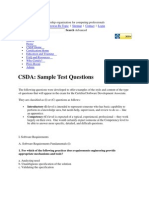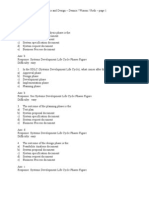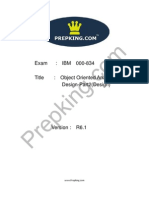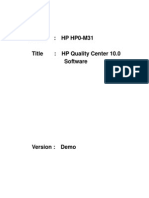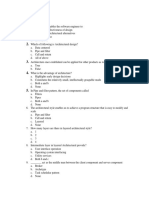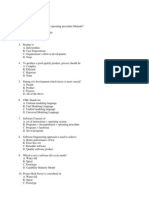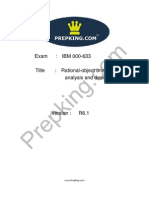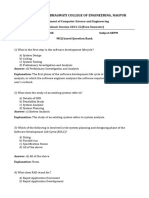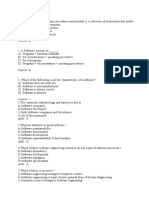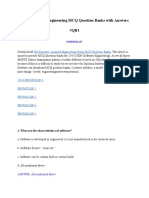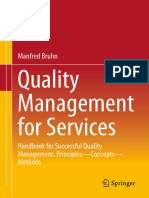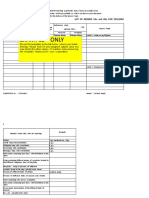Prepking 000-639 Exam Questions
Prepking 000-639 Exam Questions
Uploaded by
kerris123Copyright:
Available Formats
Prepking 000-639 Exam Questions
Prepking 000-639 Exam Questions
Uploaded by
kerris123Copyright
Available Formats
Share this document
Did you find this document useful?
Is this content inappropriate?
Copyright:
Available Formats
Prepking 000-639 Exam Questions
Prepking 000-639 Exam Questions
Uploaded by
kerris123Copyright:
Available Formats
Exam Title
: IBM 000-639 : Rational Unified Process
Version :
R6.1
www.Prepking.com
Prepking - King of Computer Certification Important Information, Please Read Carefully
Other Prepking products A) Offline Testing engine Use the offline Testing engine product to practice the questions in an exam environment. B) Study Guide (not available for all exams) Build a foundation of knowledge which will be useful also after passing the exam. Latest Version We are constantly reviewing our products. New material is added and old material is updated. Free updates are available for 90 days after the purchase. You should check your member zone at Prepking and update 3-4 days before the scheduled exam date. Here is the procedure to get the latest version: 1.Go towww.Prepking.com 2.Click on Member zone/Log in (right side) 3. Then click My Account 4.The latest versions of all purchased products are downloadable from here. Just click the links. For most updates,it is enough just to print the new questions at the end of the new version, not the whole document. Feedback If you spot a possible improvement then please let us know. We always interested in improving product quality. Feedback should be send to feedback@Prepking.com. You should include the following: Exam number, version, page number, question number, and your login ID. Our experts will answer your mail promptly. Copyright Each PDF file contains a unique serial number associated with your particular name and contact information for security purposes. So if we find out that a particular PDF file is being distributed by you, Prepking reserves the right to take legal action against you according to the International Copyright Laws. Explanations This product does not include explanations at the moment. If you are interested in providing explanations for this exam, please contact feedback@Prepking.com.
www.Prepking.com
1. When does integration occur in an iterative lifecycle? A. In Elaboration, Construction, and Transition iterations, and sometimes in Inception. B. Only at the end of Elaboration and Construction. C. Only in iterations that produce external releases. D. Only at the end of Elaboration, Construction, and Transition. Answer: A 2. What role is typically responsible for the Risk List artifact? A. Project Reviewer B. Configuration Manager C. Process Engineer D. Project Manager Answer: D 3. At the end of what phase will you find the Initial Operational Capability (IOC) Milestone? A. Implementation B. Construction C. Transition D. Elaboration E. Inception Answer: B 4. Which of the following are evaluation criteria for reaching the Lifecycle Objectives Milestone? (Select all that apply.) A. Stakeholders concur on scope definition and cost/schedule estimates B. The key approaches to be used in test and evaluation are proven. C. There is a shared understanding of the subset of requirements that have been captured so far. D. All risks have been identified and a mitigation strategy exists for each. Answer: ACD 5. Which of the following is true about the generalization relationship? A. It is represented by a dashed arrow. B. It is represented by a diamond symbol. C. It is a special form of aggregation. D. It is often called inheritance. Answer: D 6. What does the term "artifact" indicate in Rational Unified Process? A. A unit of work to be performed. B. A piece of information that the process produces, modifies, or uses.
www.Prepking.com
C. A major workflow of Rational Unified Process itself. D. The specific job position that must perform the activity. Answer: B 7. Which of the following statements characterize a class diagram? (Select all that apply.) A. It can be drawn using UML notation. B. It shows a sequence of interactions between classes. C. It can be used to represent information within the logical and process views. D. It can provide a view of high-level packages or the details of a single package. E. It shows the states and transitions of a class. Answer: ACD 8. Which of the following statements are true concerning the Development Case? (Select all that apply.) A. You can use it to specify the degree of formality associated with an artifact. B. It is fixed during Inception and does not generally change over the course of a project. C. You can use it to specify the tools used to produce an artifact. D. It tells you which artifacts to produce. Answer: ACD 9. What is an Iteration Workflow? A. Some action that a role performs, which provides a meaningful result in the context of the project B. A collection of activities within an iteration, which are related to a major "area of concern" C. A sequential view of the process, describing a typical workflow within an iteration of a given phase D. A cycle of Inception, Elaboration, Construction, Transition Answer: C 10. Which of the following statements characterize project metrics in Rational Unified Process? (Select all that apply.) A. They provide insight into progress and quality. B. They are useful in tracking trends in important variables such as rework. C. They should not be collected on early iterations. D. They must be collected manually to be accurate. E. They are the basis for iteration assessment. Answer: ABE 11. Which one of the following Test artifacts is the step-by-step instructions that realize a test, enabling its execution? A. Test Case B. Test Class C. Test Script
www.Prepking.com
D. Test Suite Answer: C 12. Which of the following are software engineering best practices recommended by Rational Unified Process? (Select all that apply.) A. Develop iteratively. B. Use component architectures. C. Manage change. D. Maximize reuse. E. Freeze requirements at project inception. Answer: ABC 13. Which of the following are aspects of software quality in Rational Unified Process? (Select all that apply.) A. Functionality B. Subsystem Integration C. Application Performance D. Reliability Answer: ACD 14. Which of the following can impact the scope of an iteration? (Select all that apply.) A. The current phase of the project B. Required system functionality C. The project's specific objectives D. The project's top risks Answer: ABCD 15. Which of the following belong in a typical set of architectural views? (Select all that apply.) A. Logical view B. Use-case view C. Design view D. Deployment view E. Implementation view Answer: ABDE 16. Which of the following are true about a use-case realization? (Select all that apply.) A. It may be represented using sequence diagrams. B. It identifies what classes will be required to implement some use case behavior. C. It may be represented using collaboration diagrams. D. It ties together use cases from the use-case model with classes in the design models through realization
www.Prepking.com
relationships. Answer: ABCD 17. Which of the following help to define the Iteration Plan? (Select all that apply.) A. The current status of the project B. The Development-Organization Assessment artifact C. A list of risks you must address by the end of the iteration D. A list of scenarios or use cases you must complete by the end of the iteration Answer: ACD 18. In what lifecycle phase is software architecture the primary focus? A. Elaboration B. Implementation C. Design D. Transition E. Inception Answer: A 19. Which of the following are purposes of a workflow detail? (Select all that apply.) A. To show how activities are performed parallel to each other rather than in sequence or all at once. B. To show involved roles, activities, and input and output artifacts C. To show groupings of activities that are often performed together D. To define all activities that are a part of the project Answer: ABC 20. What is a model? A. An item that is only needed if an OO coding language is used B. The semantic equivalent of the software architecture document C. A complete yet typically abstract description of a system from a particular perspective D. The same thing as a diagram Answer: C 21. How do you represent an actor in basic UML notation? A. Rectangle containing the actor's name B. Arrow C. Rectangle with three compartments D. Oval E. Stick figure Answer: E 22. Which of the following is true with respect to a typical RUP iterative lifecycle project?
www.Prepking.com
A. Detailed iteration plans must be completed during the Inception phase for the entire project. B. Planning is done incrementally, starting with coarse-grained planning followed by fine-grained planning. C. Planning is rarely done. D. Planning is done only at the start of each phase. E. Detailed iteration planning is done first. Answer: B 23. What phrase best describes round-trip engineering? A. Another name for a development cycle B. A term for the rework done in an iterative lifecycle C. A technique for keeping the design model development cycle D. Another name for the iterative lifecycle E. The practice of developing software in parallel with installation and testing of the hardware Answer: C 24. UML activity diagrams are used to describe what part of Rational Unified Process? A. Activities within a workflow detail B. Role responsibilities C. Workflow diagrams for each discipline D. The flow of information between major artifacts Answer: C 25. Which of the following statements are correct concerning the general iterative development philosophy within Rational Unified Process? (Select all that apply.) A. Early iterations should address the greatest risks. B. As a general rule, activities from all disciplines are applied in each iteration to build the system incrementally. C. Use of the waterfall lifecycle, rather than iterative lifecycle, usually delays risk reduction. D. With the possible exception of Inception iterations, each iteration should produce an executable release. E. When using an iterative lifecycle, testing only takes place after all of the coding iterations in the Construction phase have been completed. Answer: ABCD 26. Which of the following statements characterize a typical iteration in the Transition phase? (Select all that apply.) A. It produces end-user support materials such as release notes. B. It results in creation of the Development Case for the project. C. It results in selection of an architectural baseline. synchronized with the source code throughout a
www.Prepking.com
D. It makes the product available for use by its intended end users. E. It requires significant reviews of and changes to the Vision. Answer: AD 27. What statement is true of iterations? A. You establish plans for each phase, but not for iterations. B. Only Transition iterations result in executable releases. C. A lifecycle phase will be addressed by at least one iteration. D. A Construction iteration cannot include any requirements activities. E. As a general rule, iterations contain many lifecycle phases. Answer: C 28. The project manager is typically responsible for which of the following artifacts? (Select all that apply.) A. Design Guidelines B. Iteration Assessment C. Status Assessments D. Business Case E. Software Development Plan Answer: BCDE 29. Which of the following are important concerns in software architecture? (Select all that apply.) A. Describing the significant elements of a system, their interfaces, their collaborations, and their composition B. Selecting the key structural elements and interfaces for composing a system C. Composing structural and behavioral elements into logical subsystems D. Creating a detailed class design E. Specifying significant behavior in terms of collaborations among structural elements Answer: ABCE 30. Which of the following statements characterize a typical iteration in the Elaboration phase? (Select all that apply.) A. It contributes significantly to the Software Architecture Document. B. It produces executable software. C. It updates the Risk List. D. It requires the leadership of the software architect. E. Its focus is on the development of the Vision and Business Case. Answer: ABCD 31. Which of the following artifacts are typically the responsibilities of the software architect? (Select all that apply.)
www.Prepking.com
A. Architectural Proof-of-Concept B. Design Model C. Software Architecture Document D. Implementation Model E. Data Model Answer: ABCD 32. How is a class represented in basic UML notation? A. Arrow B. Rectangle containing the object's name C. Oval D. Rectangle with three compartments E. Stick figure Answer: D 33. Which of the following statements characterize good software architectures? (Select all that apply.) A. They enable economically significant reuse. B. They are maintainable and extensible. C. They are highly complex. D. They permit a clear division of work among teams of developers. E. They encapsulate hardware and system dependencies. Answer: ABDE 34. When does an iterative lifecycle enable users/customers to participate in the development process? A. Only at the beginning and at the end of the schedule B. In potentially every iteration, to review releases and provide input C. When documentation must be generated D. Only at major milestones Answer: B 35. Which of the following are important decisions in Analysis and Design? (Select all that apply.) A. Whether to generate code B. How to perform the workflow C. How to use artifacts D. Which reports to use E. How to monitor and control the project Answer: ABCD 36. What is a Development Case? A. The development process that you have chosen to follow in your project
www.Prepking.com
B. A sample architectural design used to guide architectural decisions C. A development cycle specifically devoted to maintenance D. Another name for a key mechanism Answer: A 37. Which of the following statements are true concerning requirements? (Select all that apply.) A. Use cases are used to represent functional requirements. B. Legal and regulatory requirements are usually best captured in use cases. C. Most systems do not need any supplementary specifications. D. Most systems have no performance requirements. E. Supplementary specifications capture requirements that cannot easily be expressed as use cases. Answer: AE 38. Which of the following statements are correct concerning Rational Unified Process (RUP)? (Select all that apply.) A. RUP is a process described in terms of roles, activities and artifacts. B. RUP provides advice for using software tools effectively. C. RUP is the basis for the UML standard. D. RUP embodies many proven practices and provides a process definition in support of those practices. E. RUP provides guidelines for efficient development of quality software. Answer: ABDE 39. Which of the following are recommended practices according to the Implementation discipline? (Select all that apply.) A. You can use code reviews in place of developer testing. B. Implementation occurs only in the Construction phase. C. Implementers debug and test the elements they implement. D. The software architect structures the Implementation Model. E. You implement classes and objects. Answer: CDE 40. Which of the following statements characterize the Implementation view of architecture in Rational Unified Process? (Select all that apply.) A. It includes component diagrams illustrating how subsystems are organized in layers and hierarchies. B. It shows the allocation of classes to processes. C. It contains an enumeration of all subsystems in the implementation model. D. It shows how classes run on computing nodes. E. It is primarily the concern of customers and users. Answer: AC
www.Prepking.com
100% Pass Guaranteed or Full Refund Word to Word Real Exam Questions from Real Test Buy full version of exam from this link below http://www.prepking.com/000-639.htm
You might also like
- CSDA: Sample Test Questions: Home About Help Browse by Topic Sitemap Contact LoginDocument30 pagesCSDA: Sample Test Questions: Home About Help Browse by Topic Sitemap Contact LoginMunini K. PierreNo ratings yet
- Scrum Developer AssessmentDocument11 pagesScrum Developer Assessmentmohannad44% (9)
- Unit 7 - 8 - 9Document11 pagesUnit 7 - 8 - 9Samantha Jiménez Suárez100% (1)
- Software Engineering Solved McqsDocument22 pagesSoftware Engineering Solved Mcqsshilpareddy88871% (48)
- CH 01Document27 pagesCH 01Imran InamNo ratings yet
- English File Pre-Intermediate, Third Edition CEFR Mapping - Oxford PDFDocument47 pagesEnglish File Pre-Intermediate, Third Edition CEFR Mapping - Oxford PDFMini Gameword02100% (2)
- Prepking 000-833 Exam QuestionsDocument11 pagesPrepking 000-833 Exam Questionsjanes32No ratings yet
- Prepking 000-834 Exam QuestionsDocument11 pagesPrepking 000-834 Exam Questionsandrew231No ratings yet
- Exam: HP HP0-M31Document9 pagesExam: HP HP0-M31BladeNo ratings yet
- MCQ Se&pm 2019-2020 Q & ADocument78 pagesMCQ Se&pm 2019-2020 Q & ASudhisha ZareNo ratings yet
- 300 Software Engineering Multiple Choice Questions MCQs 2024Document45 pages300 Software Engineering Multiple Choice Questions MCQs 2024ximeni2516No ratings yet
- Software Engineering MCQsDocument40 pagesSoftware Engineering MCQsVansh VasNo ratings yet
- 191AIE504T - Software Engineering MCQ Banks With Answers: ANSWER: All Mentioned AboveDocument17 pages191AIE504T - Software Engineering MCQ Banks With Answers: ANSWER: All Mentioned AboveK.P.Revathi Asst prof - IT DeptNo ratings yet
- System Analysis Design MCQ Worksheet For Exit Exam 2015@Document20 pagesSystem Analysis Design MCQ Worksheet For Exit Exam 2015@Magarsaa100% (2)
- Software Engineering Solved McqsDocument16 pagesSoftware Engineering Solved McqsRida BaigNo ratings yet
- Software Engineering Solved Mcqs PDFDocument16 pagesSoftware Engineering Solved Mcqs PDFPuskin MittalNo ratings yet
- Technology In Action Complete 9th Edition Evans Test Bank 2024 scribd download full chaptersDocument60 pagesTechnology In Action Complete 9th Edition Evans Test Bank 2024 scribd download full chaptersraliazoulea100% (4)
- CS 2340 Fall 2021 Practice Exam 1Document3 pagesCS 2340 Fall 2021 Practice Exam 1FED FDSKLJKNo ratings yet
- Project Management SAMPLE MCQDocument70 pagesProject Management SAMPLE MCQshubh agrawalNo ratings yet
- Software EngineeringDocument66 pagesSoftware EngineeringShantanu ChouguleNo ratings yet
- Sepm Mcqs PDF 2022Document50 pagesSepm Mcqs PDF 2022Apoorva RodeNo ratings yet
- Software Engineering MCQsDocument37 pagesSoftware Engineering MCQsjoejoma3No ratings yet
- Quiz ZZZZDocument40 pagesQuiz ZZZZRana Abdul RehmanNo ratings yet
- SE MCQDocument14 pagesSE MCQBhaskarPadmanabhanNo ratings yet
- Unit 2 Software Engineering MCQ PDFDocument20 pagesUnit 2 Software Engineering MCQ PDFBRUTAL THORNo ratings yet
- Software Engineering Mcqs Set1Document27 pagesSoftware Engineering Mcqs Set1MAHAMA SADIK100% (2)
- Software EngineeringDocument44 pagesSoftware EngineeringKALI CHARANNo ratings yet
- Se MCQSDocument8 pagesSe MCQSSyeda Rutab AzizNo ratings yet
- TOGAF Part 1 Practice TestDocument15 pagesTOGAF Part 1 Practice Testhamsaplohus100% (2)
- MCQ SeDocument11 pagesMCQ SeJyotirmaya Nayak100% (1)
- Prepking 000-633 Exam QuestionsDocument11 pagesPrepking 000-633 Exam Questionskriss111No ratings yet
- SE Objective ImportantDocument12 pagesSE Objective ImportantSuseela ReddyNo ratings yet
- f6f667bf-a016-4f0a-88da-537686553c72Document36 pagesf6f667bf-a016-4f0a-88da-537686553c72Wiki EthiopiaNo ratings yet
- Software Testing (STE)Document36 pagesSoftware Testing (STE)Vinod MarneNo ratings yet
- Forms: Ans: ADocument14 pagesForms: Ans: AMina AshrafNo ratings yet
- Test SADDocument17 pagesTest SADleulz3000No ratings yet
- Sen QB2Document10 pagesSen QB2quyenNo ratings yet
- TCS Exam SDLM AnswersDocument3 pagesTCS Exam SDLM AnswersNalini RayNo ratings yet
- Istqb Q - ADocument75 pagesIstqb Q - Asrini8558No ratings yet
- Stqa MCQ 1Document16 pagesStqa MCQ 1Ashvini Avinash BamanikarNo ratings yet
- Software Engineering Part 1 50 MCQ CEXAMINDIA (1) - UnlockedDocument7 pagesSoftware Engineering Part 1 50 MCQ CEXAMINDIA (1) - UnlockedAditya SharmaNo ratings yet
- Software Engineer MCQSDocument68 pagesSoftware Engineer MCQSsabiha kamranNo ratings yet
- AgileDocument18 pagesAgilechandan mathurNo ratings yet
- SEPM MCQ - PriyadarshaniDocument20 pagesSEPM MCQ - PriyadarshaniApoorva RodeNo ratings yet
- Prototyping Involves in Software: Answer - Click HereDocument4 pagesPrototyping Involves in Software: Answer - Click Hereali abbasNo ratings yet
- Unit 1Document4 pagesUnit 1rajdattaNo ratings yet
- W11 MidtermDocument5 pagesW11 MidtermAbdi MafNo ratings yet
- C PM 71.v2016-12-11 PDFDocument31 pagesC PM 71.v2016-12-11 PDFbobi2201No ratings yet
- 303e - Object Oriented Analysis & DesignDocument38 pages303e - Object Oriented Analysis & Designmakoua1983No ratings yet
- PTTKYCDocument9 pagesPTTKYCnguyenharry200No ratings yet
- DFA L1 For CL12-13 - All AnswersDocument18 pagesDFA L1 For CL12-13 - All AnswersLester CruzNo ratings yet
- Software Project Management: Multiple Choice Questions & AnswersDocument35 pagesSoftware Project Management: Multiple Choice Questions & AnswersArbina Chagala0% (1)
- Immediate download Technology In Action Complete 12th Edition Evans Test Bank all chaptersDocument49 pagesImmediate download Technology In Action Complete 12th Edition Evans Test Bank all chaptersrodeywliam100% (6)
- ISTQB Latest Sample Paper 1Document9 pagesISTQB Latest Sample Paper 1Kiran KumarNo ratings yet
- Software Engineering MCQ Question Banks With Answers #QB3Document6 pagesSoftware Engineering MCQ Question Banks With Answers #QB3avniNo ratings yet
- Rup - 839Document43 pagesRup - 839Alessandra Chollet Moreira AlvarengaNo ratings yet
- Software Engineering MCQ Question Banks With Answers #QB1Document18 pagesSoftware Engineering MCQ Question Banks With Answers #QB1Omkar KhutwadNo ratings yet
- SEN - MCQ (All Chapter)Document65 pagesSEN - MCQ (All Chapter)Saquibh ShaikhNo ratings yet
- Software-Testing-Quality-Assurance (Set 1)Document21 pagesSoftware-Testing-Quality-Assurance (Set 1)mm6923605No ratings yet
- Salesforce Certified Platform Developer I CRT-450 Exam PreparationFrom EverandSalesforce Certified Platform Developer I CRT-450 Exam PreparationNo ratings yet
- Lesson 14 - Traumatic Injuries. Infections, NursingDocument29 pagesLesson 14 - Traumatic Injuries. Infections, NursingAlejandro GuerreroNo ratings yet
- 84-Article Text-508-2-10-20200531Document10 pages84-Article Text-508-2-10-20200531Hanafi AlganiNo ratings yet
- 2023, QM ServicesDocument645 pages2023, QM Servicescamivo6386No ratings yet
- 541Document3 pages541ield2631No ratings yet
- Aims MathematicsDocument19 pagesAims MathematicsBoutiara AbdellatifNo ratings yet
- CCPP ID: Not Assigned: Basic InformationDocument2 pagesCCPP ID: Not Assigned: Basic InformationAmresh PattnaikNo ratings yet
- THESISDocument21 pagesTHESISjayppeluzanoNo ratings yet
- Baburao ResumeDocument2 pagesBaburao ResumePonangi Babu RaoNo ratings yet
- Princess Cruise Ship - Curriculum VitaeDocument2 pagesPrincess Cruise Ship - Curriculum VitaeRichelle WskiNo ratings yet
- Machine LearningDocument24 pagesMachine LearningHari KrishnanNo ratings yet
- Assignment 10.2: Bshoffman@vt - EduDocument3 pagesAssignment 10.2: Bshoffman@vt - Eduapi-599798491No ratings yet
- Group 5 - The Effects of Technology in Students' Academic PerformanceDocument11 pagesGroup 5 - The Effects of Technology in Students' Academic PerformancePhilip Llave100% (2)
- Unza PG RegulationsDocument86 pagesUnza PG RegulationsWei LeeNo ratings yet
- Business Process Analysis C Business-Critical Process, System, and Can Access Their Stakeholders For AnalysisDocument2 pagesBusiness Process Analysis C Business-Critical Process, System, and Can Access Their Stakeholders For AnalysisPradeep SankarNo ratings yet
- 2018 Accomplishment Report: San Lorenzo Ruiz Elementary School Special Education CenterDocument6 pages2018 Accomplishment Report: San Lorenzo Ruiz Elementary School Special Education CenterYahj BulalacaoNo ratings yet
- Dissertation Ideas English LanguageDocument7 pagesDissertation Ideas English LanguageWebsiteThatWritesPapersForYouSingapore100% (1)
- CSE2002 Data - Structures - and - Algorithm - BL2023241000790 - CCM - DR Dheresh SoniDocument57 pagesCSE2002 Data - Structures - and - Algorithm - BL2023241000790 - CCM - DR Dheresh SoniDheresh SoniNo ratings yet
- Number of Seats: Indian Statistical InstituteDocument2 pagesNumber of Seats: Indian Statistical InstituteTreanungkur MalNo ratings yet
- Get Psychology Basics Magill s Choice Revised Edition Nancy A. Piotrowski - Editor PDF ebook with Full Chapters NowDocument55 pagesGet Psychology Basics Magill s Choice Revised Edition Nancy A. Piotrowski - Editor PDF ebook with Full Chapters NowstefiejenuzNo ratings yet
- Example Only: List of Needed Vas and Ims For TeachingDocument16 pagesExample Only: List of Needed Vas and Ims For TeachingJalefaye Talledo AbapoNo ratings yet
- Shakespeare in The Bush Essay ExampleDocument7 pagesShakespeare in The Bush Essay ExampleKanza ChaudhryNo ratings yet
- Bài KT 1 K Năng T NG H P 1 B2Document3 pagesBài KT 1 K Năng T NG H P 1 B2Quang Thịnh LêNo ratings yet
- CNP 4Document22 pagesCNP 4Aregahagn NesruNo ratings yet
- Eamon Duffy ProfileDocument2 pagesEamon Duffy Profileprince_chineeNo ratings yet
- Gerald Young (Auth.) - Unifying Causality and Psychology - Being, Brain, and Behavior-Springer International Publishing (2016) PDFDocument962 pagesGerald Young (Auth.) - Unifying Causality and Psychology - Being, Brain, and Behavior-Springer International Publishing (2016) PDFmar1940100% (1)
- (Teacher) Bk12 Online Day 2Document56 pages(Teacher) Bk12 Online Day 2Michelle Estolano Casinillo100% (1)
- Accomplishment Report On SHS Immersion ProgramDocument4 pagesAccomplishment Report On SHS Immersion ProgramHannae pascua100% (2)
- Gel Incorporation Inside of Organic Single Crystals Grown in Agarose Hydrogels - AgaroseDocument3 pagesGel Incorporation Inside of Organic Single Crystals Grown in Agarose Hydrogels - AgaroseDamian PalinNo ratings yet
